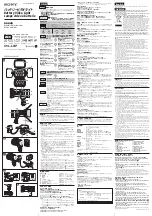
VPC-HD22
VPC-HD22 Product Specification & Operational Manual
10
8. Guideline for Thermal design
This camera is designed for embedding into a chassis, therefore, operating the board itself without heat
release will exceed the tolerance of the operation temperature. The operation temperature will reach 130
℃
when operating FPGA without casing. Do not leave it on without casing as it may cause burns and damages
to the camera. Please refer to the guideline below for designing heat dissipation.
8.1. Operating temperature of main parts
Board(ref)
Data sheet value
Upper limit temperature of
IC package surface
Image sensor
BI-VC01PA(IC1)
ta=75
℃
85
℃
FPGA
MB-VC01(IC1)
ta=85
℃
80
℃
CPU
MB-VC01(IC4)
ta=85
℃
95
℃
SDI IC
PD-VC01(IC3)
ta=85
℃
95
℃
Upper limit temperature of the package is ta+10
℃
for parts defined “ta” on a data sheet.
As the data sheet value of FPGA says “tj,” upper limit temperature of FPGA shall be 80
℃
based on the thermal
conductivity of the package and power consumption.
Please release heat so that surface temperature of the IC package on a board in a chassis does not exceed the
upper limit temperature. Please measure the temperature in the usage environment.
Give first priority to the heat dissipation of the FPGA because it is the main heat source.
8.2. Temperature measurement of the surface of the device.
Measure temperature by fixing a thermocouple to the device surface with tape, making a slit in the heat
conduction sheet, and adhering a heat-sink tightly onto it.
(E.g.
:
Temperature measurement of the surface of FPGA)
8.3. Reference> surface temperature of each device in a Pacific chassis(29mm×29mm×77mm)
Ambient
Temperature
25
℃
40
℃
45
℃
Image sensor
58
73
78
FPGA
55.7
70.7
75.7
CPU
51.7
66.7
71.7
SDI IC
55.1
70.1
75.1
































